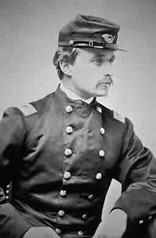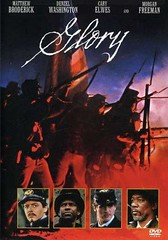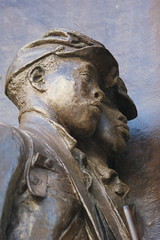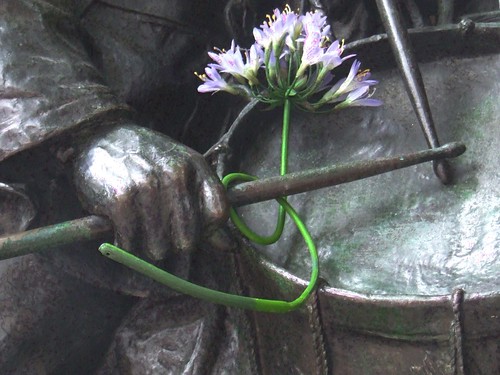A brief excerpt from a PBS documentary on the sculptor Saint-Gaudens, who created the Shaw Memorial on Boston Common. We take it for granted 364 days a year but Memorial Day seemed like a good time to stop and take a closer look. What memorials are in your town?
I don't know how many times I have walked by this statue--hundreds?--and never stopped to think much about it. It's part of the fabric of the city. We learned all about it in school. I saw the movie "Glory", which was Hollywood's version of who these people were. You probably saw it too.
But the other night I stopped there at the top of Boston's Beacon Hill because I was taken with the horse and I wanted to see it close up.
It struck me that the foot soldiers are all leaning forward. But the rider and horse are not. In fact, they seem a bit hesitant. The horse's ears are back.
That's when I decided to start doing some more reading. And start forgetting Hollywood.
As soon as the Civil War began, African-American men in the North tried to enlist in the Union Army. They were turned away.
 |
| Colonel Shaw ended up in an unmarked grave with his fallen black soldiers. |
They knew was they were up against. Confederacy policy was to enslave any captured Black soliders.
The governor of Massachusetts assured them that African American soldiers would be treated equally; they would receive the same pay and the same benefits as white recruits.
Only white men, however, could serve as officers. Colonel Robert Gould Shaw, the only son of one of Boston's leading abolitionist families, would lead the regiment. He was only 25 years old.
 |
| Hollywood made Americans much more aware of the 54th. |
One of their first engagements was on July 18th at Fort Wagner, in Charleston Harbor in South Carolina. Colonel Shaw led 600 men up the embankment. Almost half his men were killed, wounded, or captured.
Colonel Shaw was shot through the heart; the Confederates buried him in a common (unmarked) grave alongside 74 of his men.
 |
| Who were the black men who modeled for the sculptor? |
The War Department, meanwhile, did not deliver on the governor's promise to the soldiers. The men of the 54th were paid only $10 per month--$3 less than the white soldiers.
So, they decided if they could not receive equal pay, they would accept no pay.
For 18 months, soldiers could send no money home. In turn, they received heartbreaking letters from their impoverished families back in Massachusetts.
Finally, in July 1864, Congress acted to give African-American soldiers the equal pay they had been promised, retroactive to the date of their enlistments.
Memorial Day was declared a holiday in 1868, so that Americans would stop what they were doing and place flowers on the graves of fallen soldiers--a custom that began in Mississippi. It was called Decoration Day.
On May 31, 1897, 60 veterans of the 54th Regiment were among hundreds of people who gathered on the Common for the unveiling of the memorial. This bronze relief statue, which took the leading sculptor in the United States 14 years to create, is considered one of the greatest works of public art in the United States and was the first to portray black men in uniform.
Sculptor Saint-Gaudens' original plan was to craft a magnificent equestrian statue of Shaw--alone on his horse, on a pedestal. But Shaw's family wouldn't hear of it. Saint-Gaudens bought into their line of thinking and designed the first public sculpture to show an officer and enlisted soldiers together.
And, probably, blacks and whites together.
It was commissioned by the black citizens of Massachusetts, who raised funds to pay Saint-Gaudens. I'm just not sure why it is called the Robert Gould Shaw memorial. I hope someday I'll hear that its name will be changed to honor the whole regiment.
When it was unveiled back in 1897, people could read the names of the five white officers killed in battle; they were inscribed on the back of the monument.
It wouldn't be until 1981 that the names of the fallen black soldiers would be carved into that stone.
To learn more:
Follow Hoofcare + Lameness on Twitter: @HoofcareJournal
Read this blog's headlines on the Hoofcare + Lameness Facebook Page
Disclosure of Material Connection: I have not received any direct compensation for writing this post. I have no material connection to the brands, products, or services that I have mentioned, other than Hoofcare Publishing. I am disclosing this in accordance with the Federal Trade Commission’s 16 CFR, Part 255: Guides Concerning the Use of Endorsements and Testimonials in Advertising.



